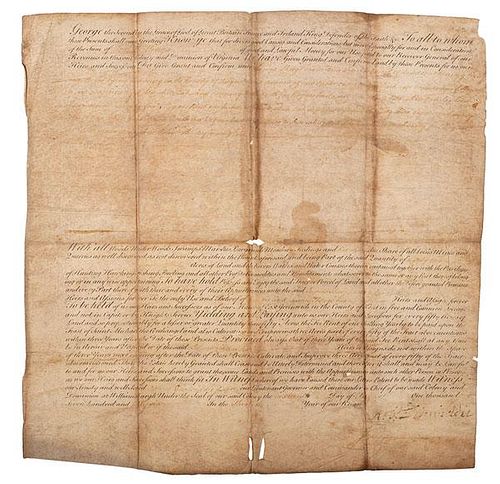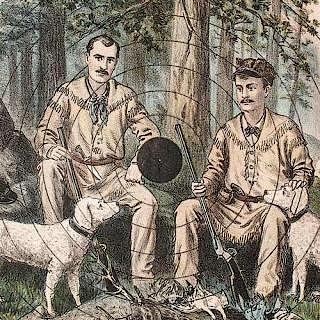Famous Virginia Governors, Incl. Dinwiddie, Lee, Letcher, & Kemper, Signed Montgomery County Land Deeds
About Seller
6270 Este Ave.
Cincinnati , OH 45232
United States
With offices in Cincinnati, Cleveland and Denver, Cowan’s holds over 40 auctions each year, with annual sales exceeding $16M. We reach buyers around the globe, and take pride in our reputation for integrity, customer service and great results. A full-service house, Cowan’s Auctions specializes in Am...Read more
Two ways to bid:
- Leave a max absentee bid and the platform will bid on your behalf up to your maximum bid during the live auction.
- Bid live during the auction and your bids will be submitted real-time to the auctioneer.
Bid Increments
| Price | Bid Increment |
|---|---|
| $0 | $25 |
| $500 | $50 |
| $1,000 | $100 |
| $2,000 | $250 |
| $5,000 | $500 |
| $10,000 | $1,000 |
| $20,000 | $2,500 |
| $50,000 | $5,000 |
| $100,000 | $10,000 |
About Auction
Nov 20, 2015 - Nov 21, 2015
Cowan's Auctions dawnie@cowans.com
- Lot Description
Famous Virginia Governors, Incl. Dinwiddie, Lee, Letcher, & Kemper, Signed Montgomery County Land Deeds
Four documents representing over a century of Virginia history, plus a hand-drawn land survey map of land along Meadow Creek, near the Ingles Ferry area on the New River in southwest Virginia.
Partially printed document, vellum, approx. 13.75 in. square, Williamsburgh [old sp.], Aug. 16, 1756. Signed by Robert Dinwiddie (1693-1770) Lt. Gov. of colonial Virginia (1751-1758). Some historians have (for the most part unfairly) blamed Dinwiddie for starting the French and Indian War, but others have demonstrated that it likely began several years before he became involved. He was a stockholder in the Ohio Company, and took actions attempting to prevent the French from expanding south. At the time, Virginia claimed much of what became the Northwest Territory. Dinwiddie sent eight men under George Washington to Fort Le Boeuf in the winter of 1753-54 with a message inviting the French to leave the region. Without waiting for a response, Dinwiddie then sent a small group of militia to build a fort at what would be later-day Pittsburgh, but the French overran the Virginians and built Fort Duquesne. Many territorial battles ensued, causing conflict over the financing of the war. Dinwiddie returned to England in 1758 and remained there the rest of his life.
Partially printed document, vellum, 12.5 x 15 in. Richmond, VA, May 17, 1793. For 50 acres along Meadow Creek to James Simpkins (presume 1757-1833). Signed by Henry (“Light Horse Harry”) Lee as Governor of the Commonwealth of Virginia and father of famed Confederate General R.E. Lee. Henry Lee (1756-1818) made his name during the Revolutionary War staging lightning raids, generally with little loss to his unit. He started the war in the north, attracting the attention of George Washington and earning him rapid promotions. When the theater shifted south, so did Lee. After the British surrender, he returned home to marry his cousin, Matilda. But only eight years later, she died, leaving three small children and a grieving husband. Shortly after, Lee was elected Governor of Virginia, and while in Richmond, met Ann Hill Carter. After three terms as Governor, Lee married Ms. Carter and took her to the family home, Stratford. He then served in the Continental Congress. When George Washington died, Lee gave a memorial address in which he used the now-famous phrase that the former President was “First in war, first in peace and first in the hearts of his countrymen…”
Partially printed document, vellum, 11 x 13.25 in. Richmond, VA, April 1, 1863, signed by John Letcher as Governor. For 736 acres on “both sides of Meadow Creek” to James H. Simpkins (1826-1910). John Letcher (1813-1884) was born in Lexington, VA. In addition to being admitted to the Virginia Bar, he was editor of the Valley Star newspaper from 1840-1850 – a perfect position for involvement in politics. He was elected to the House for most of the 1850s. In 1859 he was elected Governor of Virginia, serving through most of the Civil War, after which he returned to his law practice in Lexington. He served in the Virginia Assembly and on the Board of Visitors at VMI (see lot 56 this sale) after his term as Governor.
Partially printed document, vellum, 12.75 x 16.5 in. Richmond, VA, Dec. 1, 1877. For three+ acres on Meadow Creek to James H. Simpkins. Signed by James L. Kemper, Governor. James Lawson Kemper (1823-1895) was born in Madison County, VA, and at a local school became friends with A.P. Hill, who would be a lifelong friend. Kemper then spent winters at a boarding school that had a military corps of cadets, and moved on to Washington College and took civil engineering classes at VMI. He was admitted to the Virginia bar in 1846. He and some friends volunteered during the Mexican War, but arrived too late for any action. In 1850 Kemper became involved in politics as a pro-slavery states’ rights candidate. He lost his first election, but was later elected to the Virginia House of Delegates. He was also an advocate of military preparedness and by 1858 was a Brig. Gen. in the Virginia militia. He was Speaker of the state House from 1861-1863, while at the same time serving in the Confederate Army. He fought in a number of major battles including the Peninsula Campaign, Second Manassas, Antietam, and Gettysburg, where he was famously wounded in Pickett's Charge. He was also captured, but rescued, then captured again in September. Although too ill for battle, he was promoted to Maj. Gen. in 1864. The wound would plague him for the rest of his life. After the war he served as the first post-reconstruction Governor of Virginia (1871-1878), the end of reconstruction being made official in 1877 with the order to withdraw Federal troops.
The map is on a 15.25 x 17.5 in. sheet and is a survey of two lots of land for James H. Simpkins, by W.J. Hall, Jan. 10, 1889. For additional information, including genealogies of the Simpkins and other families of Meadow Creek, go to: http://www.historybroker.com/collection/deeds/index.htm .The land grants are in good condition, all retain their original seals, but some are faded. All have some toning, at least on the outer panels when folded. The survey map has some separations of its folds.Condition
- Shipping Info
-
SHIPPING. At the request of the buyer, Cowan's will authorize the shipment of purchased items. Shipments usually occur within two weeks after payment has been received. Shipment is generally made via UPS Ground service. Unless buyer gives special instructions, the shipping method shall be at the sole discretion of Cowan's Auctions, Inc.. Cowan's is in no way responsible for the acts or omissions of independent handlers, packers or shippers of purchased items or for any loss, damage or delay from the packing or shipping of any property.
-
- Buyer's Premium



 EUR
EUR CAD
CAD AUD
AUD GBP
GBP MXN
MXN HKD
HKD CNY
CNY MYR
MYR SEK
SEK SGD
SGD CHF
CHF THB
THB















